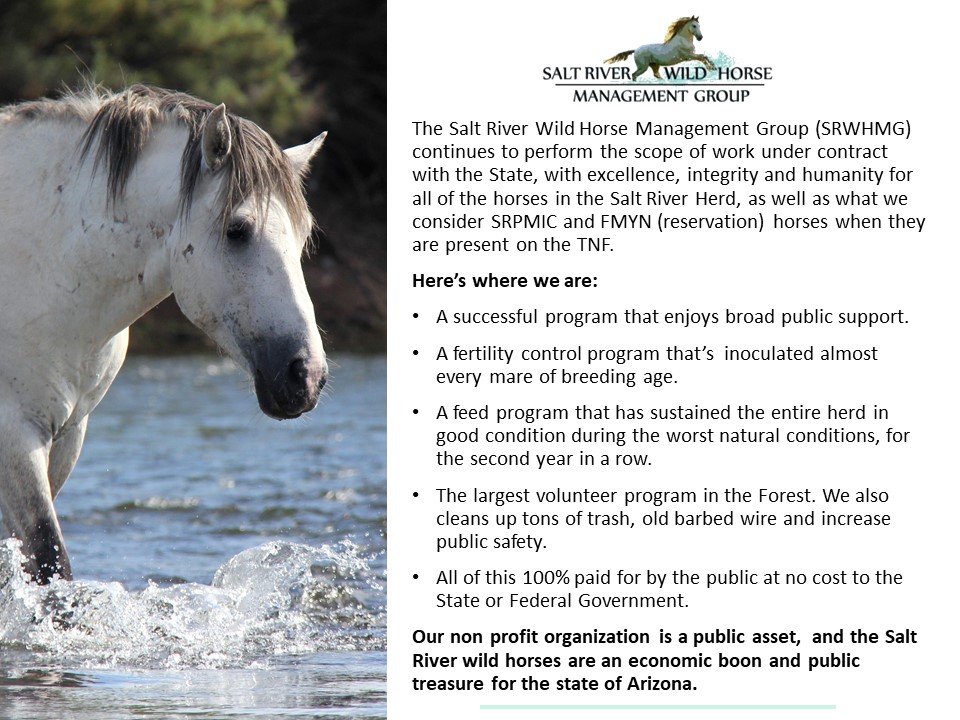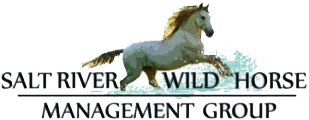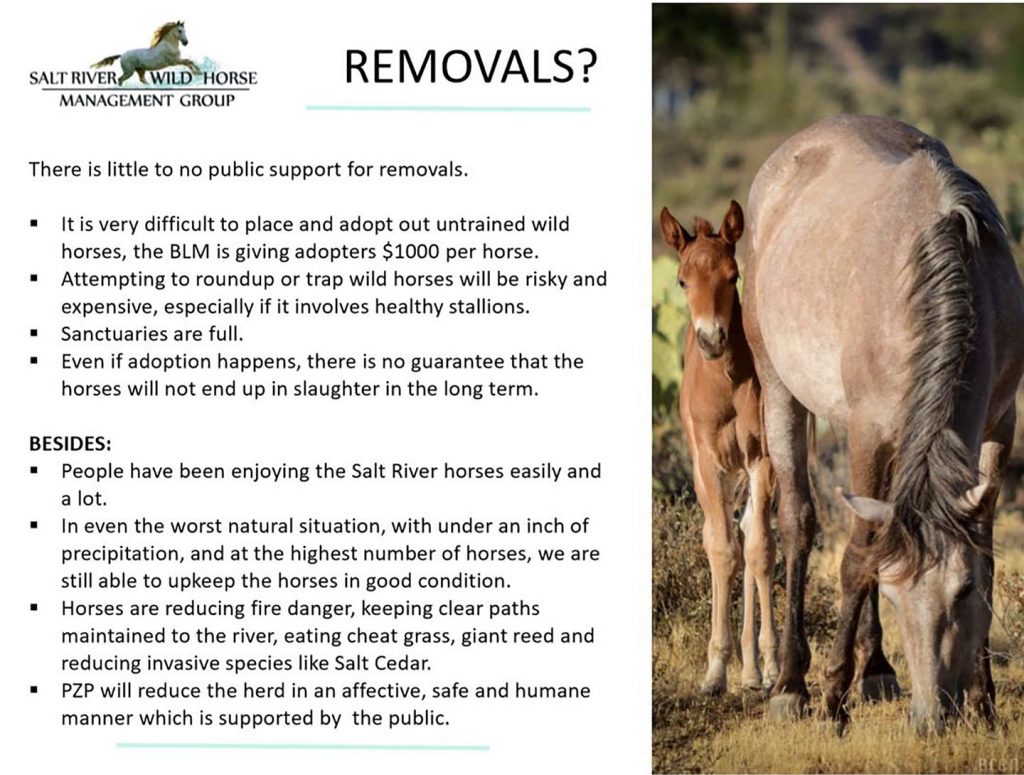
Long Term Wild Horse Management Plan.
In 2019 The Salt River Wild Horse Management Group (SRWHMG) and our coalition partner the American Wild Horse Campaign (AWHC) have worked extensively to secure long term protection for the Salt River wild horses. As 2019 comes to a close, we need to let you know that the fight for their protection is not over.
Partnership for Success As the state contractor for humane management of the Salt River horses, the SRWHMG works closely with the two government agencies that have jurisdiction over the horses — the Forest Service and the Arizona Department of Agriculture (AZDA). As part of the daily management of the horses, we consistently advocate for the welfare and safety of the horses, as well as for the safety of the public. While we do not always agree, we are grateful for the cooperation of these two agencies in striving to achieve those goals; for without these partnerships humane management would not be possible.
A Threat to the Horses However despite the State law that protects them and the successful partnership for day-to-day management of the horses, a threat to their long-term well being comes from the Salt River Horse Collaborative, which was supposed to be a stakeholder process to develop a long term management plan for the Salt River horses. The collaborative process was initiated by the Forest Service as part of the IGA (Inter Governmental Agreement) and consisted of a series of meetings organized and mediated by the agency, Concur inc.
This long term Salt River Horse management plan is referred to several times in the new DRAFT Land and Resource Management Plan which the Tonto National Forest has just released for comment. However you will not find details about the Horse management plan in the Draft Forest Plan, just references to it. We will attempt to explain the details, as it is important that everyone understand the implications that the Draft Forest Plan could have for the Salt River wild horses as well as the recommendations from the Collaborative process.
Draft Tonto Resource Management Plan The Tonto Resource Management Plan dictates how the Forest Service manages our public lands. The draft plan is extremely extensive and it is open for public comment until March 12th 2020. (90 days total). There is no hurry to comment on it right away, especially not if you have not read it. Comments to the plan have to be specific to the plan, or they will be discarded. Comments stating that you want wild horses to be protected will have no use, as they are already protected by ARS 3-1491 and the Forest Service cooperates with that State Protection. We are formulating our comments that will be specific to the Draft Plan and we will post those on our website and social media pages soon.
The draft plan mentions the Salt River wild horses on the following pages, Page 63 (referencing long term Salt River Horse Management Plan), and page 242 through 246, again referencing that everything in the draft Plan depends on the long term management plan for the Salt River wild horses. The collaborative process is also mentioned in the draft plan on page 63. The long term Salt River Horse management plan has not been set in stone and although there is not a comment period for it, you an submit your comments to the Draft Plan, as well as to the Forest Service and to the AZDA when we post the email addresses.
SRWHMG and AWHC participated in these monthly collaborative meetings that took place between December 2018 and November 2019 to defend the rights of the Salt River horses, the will of the public that wants them protected, and the state law that mandates their protection in their historic habitat along the lower Salt River. From the beginning, SRWHMG and AWHC had concerns about the unbalanced nature of the collaborative and the apparent bias of facilitators toward an outcome that would drastically reduce the Salt River horse population and its habitat in the Tonto National Forest.
Unfortunately, instead of a true stakeholder process, the Collaborative was stacked with anti-wild horse members, including conservation groups that wrongly believe that horses are non-native, and hunting, livestock and ranching interests (even though there are no grazing conflicts with the Salt River Horses!). Meanwhile, local businesses, and recreational users like kayakers, tubers and hikers and bikers — key stakeholders that support the horses as an essential part of the visitor experience — were completely shut out of the process.
We ended the collaborative with the same concerns as we began. (Click here for our letter to the collaborative.)
Three Management Plans; Only One Horse Protection Plan
Herewith you can read the final documents from the Salt River Horse Collaborative meetings. They include three options for a long term management plan for the Salt River wild horses. Click here for the original document.
Proposal 1, written by Robin Silver of the Center for Biological Diversity, was supported by the anti-horse participants, which, not coincidentally, was the vast majority of the members of the collaborative. If implemented, the plan would remove over 75 percent of the Salt River horse herd and reduce their current habitat by 40 percent its current size.
Under plan 1:
- 150 of the horses would be pushed over to Salt River Pima Maricopa Indian Community land. (which the SRPMIC does not agree with)
- 200+ horses would be removed altogether.
- A metal boundary fence along the last four miles of the lower Salt River would be constructed, where reservation lands border Forest Service land. This fence would be constructed on Forest Service land, trapping horses on the reservation side, and blocking the natural seasonal migration patterns of Salt River horses within their historic habitat.
- The last 4 miles which they call the “Coon Bluff” area (we call the Phon D area) of the Tonto Forest, as well as the south side of Bush Highway would be fenced to exclude Salt River horses.
- A wildlife overpass across Bush Highway would be allowed, but only if it were funded entirely by private resources. Given the potential million-dollar price tag for an overpass, this restriction would likely prevent it from ever being constructed.
Proposal 3 is very similar to Proposal 1 and also excludes the last four miles of the lower Salt River from the Salt River horse habitat and supports the Forest Service Boundary fence along the river. It also includes removals and adoption of Salt River wild horses until the herd reaches the number of 180-240 Salt River wild horses. The only difference between Proposals 1 and 3 is that Proposal 3 does not exclude the south side of Bush Highway from their habitat. This proposal was written by Becky Standridge of Wild Horse and Burro Collaborative, she also runs the facebook page “Salt River wild horses” (unfortunately that is not us).
Proposal 2 was written by the Salt River Wild Horse Management Group and the American Wild Horse Campaign and was supported by Wild Horse Ranch Rescue. Our proposal is the only horse protection plan, consistent with the law, it includes:
- NO REMOVALS of Salt River wild horses, except if determined in five years that our PZP fertility control program has not reduced the herd size by decreasing birth rates and through natural attrition.
- Reduction in the Salt River wild horse population to 200 horses, achieved over TEN years solely through fertility control and natural attrition.
- NO reduction of their current and historic habitat, consistent with the state law overwhelmingly passed by the legislature. (The only exclusion is a burn area that would be fenced off for fire restoration.)
- NO boundary river fence, which will have negative impacts on horses and visitor experience; the fence will be constructed along and across the river, forcing kayakers and tubers to pass through a gate! We oppose this fence particularly because of the Forest Service’s failure to disclose and seek public comment on the fence plan and it’s failure to adequately analyze the impacts of the fence to recreational users of the Forest and on the Salt River Horses.
- Our proposal also includes a rule that would make the 50 ft distance enforceable as part of the law, to keep horses and people safe.
- Our proposal also includes an overpass, built and paid for by MCDOT, so that wild horses have safe access to their historic habitat without accessing the road.
We feel this is a very reasonable proposal, that both AZDA and the Forest Service should be able to live with, especially with the extensive reduction in population numbers. This proposal will prove that wild horse management is possible without removing horses from their natural habitat.
What’s Next
The three proposals will be presented to the AZDA for a final decision for a long term management plan. Meanwhile the Forest Service will finalize the Tonto National Forest plan after the 90 day comment period, that also includes provisions that will impact the horses, based on this long term management plan.
What You Can Do
- Write a comment that makes it clear that you support Proposal 2, the Humane Management Plan for the Salt River horses, as the only proposal consistent with state law and the wishes of Arizonans.
- Oppose removals of Salt River horses and reductions to their habitat
- Oppose the boundary fence along 4 miles of the lower Salt river as detrimental to the horses and to recreational users of the Lower Salt River.
- Support the SRWHMG’s fertility control program and humane reduction of the population over ten years time without removals.
- Ask for an overpass at the location of Coon Bluff at Flag Hill. This will be the perfect spot since the horses know it well.
- Please keep these comments polite, no matter how passionate you feel, and also please thank the agencies for their cooperation in protecting the Salt River horses.
- Send a monthly donation to the Salt River Wild Horse Management group to help pay for the humane management of these horses. Even a few dollars a month makes a difference. Without your support, we cannot provide the humane management that they deserve.
We will ask you to send your comment in to 4 different places of importance: The Draft Tonto Plan website, the AZDA, the Forest Service, the Governor’s office and the request for the overpass to MCDOT. Please start writing your comments while staying tuned on where to submit it. We will provide further advice on how to formulate your comments as well, and our comment to the Draft Tonto Plan will come out soon. Hold your horses, as we have until March 12th to comment and it is important to do it right.
Once again, it’s going to take all of us speaking out and working together to #SaveSaltRiverHorses
As always, we count on your support. Thank you.
SRWHMG, managing wild horses humanely FOR the public and BY the public.

